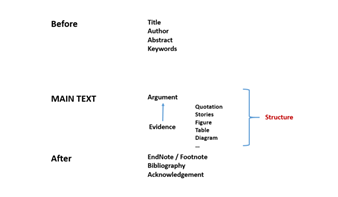Chinese Traditional Culture
Chu Culture
Introduction to Behavioral Economics
Introduction to Statistics and Applications within Data Science
Healthy China Initiative and International Health Cooperation
Intelligent Robot and Advanced Manufacturing
Smart Earth
Environment and Social Development
Infections and Immune Response
Artificial Intelligence and Big Data
Critical Conservation and Revitalization of Architecture Heritage
 选课操作指南
选课操作指南
The Outline of The Critical Conservation and Revitalization of Architectural Heritage
1. Basic Teaching Information
Course Code: |
Course Title:The Critical Conservation and Revitalization of Architectural Heritage |
||
Faculty: School of Urban Design |
Targeted Student: 200 |
||
Course Credit:1 |
Lecture Hours: (consisted of _16__ theoretical hours and __0_ practical hours) |
||
Course Leader: |
Name:Zheng Jing |
E-mail:zheng.jing@whu.edu.cn |
|
Office: |
Mobile:18571632128 |
||
Course Staff: |
Name: |
E-mail: |
|
Office: |
Mobile: |
||
Course Type:(公共基础课程Public Basic Course/基础通识课程Basic General Course/核心通识课程Core General Course/一般通识课程General Course/大类平台课程Generic Platform Course/专业必修课Compulsory Specialty Course/专业选修课程Optional Specialty Course) |
|||
Related Preview Courses:nil |
|||
2. Course Introduction(no more than 500 words)
Historic Asian cities are often regarded as the cradle of civilization and have played a vital role in the development of human societies. in the past few decades, cities across Asia have been experiencing tremendous transformations in their social, cultural, and economic structures due to an unprecedented rate of urbanization and rural-urban migration. Even as millions living in these cities currently enjoy a share of ‘progress,’ they are nevertheless under the constant threat of destruction. What is at stake is the erasure of the cultural endowments and values of various communities, and the rapid and irreversible alteration of the character of inner-city neighborhoods – these have repercussions on how people live and work, and on the preservation of urban fabric. To that end, we prepare our students with historical perspectives, cultivate intellectual tools, and acquire practical design and conservation skills to manage conservation projects of different scales and context. Our students will understand that the most pressing urban heritage management challenges cannot be solved by a single discipline but requires interdisciplinary collaborations across professions and key stakeholders.
3. The Allocation of Content and Lecture Hours
Content |
Lecture Hours |
Frontier of Architectural Heritage Theories |
5 |
Frontier of Architectural Heritage Practices |
5 |
Architectural Heritage: China and the World |
3 |
Discussion and Communication |
3 |
4. Assessment Methods and Marking Criterion
a. Please write an essay based on your case studies and feedback, strictly follow the following structure.

b. The length limit of the main text is 2000 words (1500-25 00 words are acceptable) and 10 images.
Format Instruction
a) Abstract and Introduction
Provide a one-paragraph abstract of no more than 100 words. This abstract should explain the content and structure of the paper and summarize its major findings. The abstract should be followed by a short introduction. The introduction will appear without a subheading at the beginning of the paper.
b) Subheadings
Please divide the main body of the paper with a single progression of subheadings. There need be no more than four or five of these, but they should describe the paper’s main sections and reinforce the reader’s sense of progress through the text.
c) Diagrams, Drawings And Photographs
1) Each essay can only be accompanied by a maximum of 10 illustrations.
2) Caption text and credits should not exceed 50 words per image.
3) Use identical numbering for images and captions. The first time a point is made in the main body of text that directly relates to a piece of graphic material, please indicate so at the end of the appropriate sentence with a simple reference in the form of “(FIG. 1).” Use the designation “(FIG.) ” and a single numeric progression for all graphic material.
4) Note the source of the material at the end of the caption.
d) Other Issues Of Style
In special circumstances, or in circumstances not described above, follow conventions outlined in Chicago Manual of Style (For a quick guide please refer to https://www.chicagomanualofstyle.org/tools_citationguide.html). In particular, note conventions for complex or unusual reference notes. For spelling, refer to Webster’s Dictionary.
5. Textbooks and References
· Siegfried Giedion, Space, Time and Architecture: The Growth of a New Tradition, Harvard University Press, 2003
· Kenneth Frampton, Modern Architecture A Critical History, Thames and Hudson Ltd, 1992
· Colin Rowe, the mathematics of the ideal Villa, The MIT Press, 1982
· Philip Johnson, Hitchcock, The International Style: Architecture since 1922, W. W. Norton & Companpany, 1997
· Bernard Tschumi, Architectural Concept: Red is not a Color, Rizzoli, 2012
· Mohsen Mostafavi, Gareth Doherty, ed., Ecological Urbanism, Lars Muller , 2010
· Peter Walker, Melanie Simo, eds., Invisible Gardens: the Search for Modernism in the American Landscape, The MIT Press, 1996
· Robert Venturi, the Contradiction and Complexity of Architecture, Museum of Modern Art, 1977
· Kevin Lynch, The Image of the City, The MIT Press, 1960
· Christian Norberg Schulz, Genius Loci : Towards a Phenomenology of Architecture, Rizzoli, 1979
· Amos Rapoport, House Form and Culture, Prentice Hall, 1969
· Lewis Mumford, The City in History: its Origins, it Transformations, and its Prospects, Harcourt, 1968
· Jane Jacobs, The Death and Life of Great American Cities, Vintage, 1992
· Rem Koolhaas, Delirious New York: A Retroactive Manifesto for Manhattan, 1997